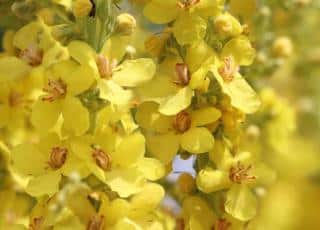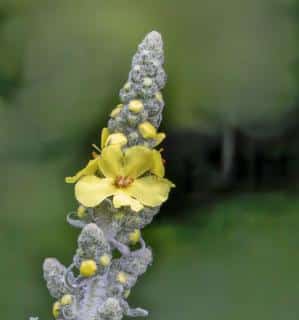

A biennial plant native to Asia and to Europe, great mullein stands out with a tall, upright cottony stem which grows between 3 and 6 ½ feet (1 to 2 meters) tall. It has a taproot and large, deeply grooved leaves that are oval in shape and are covered with whitish woolly hairs.
Its blooms are golden yellow and are quite large, with their 5 uplifted petals that are grouped into cymes along the stem.
This plant has leaves that are up to 20 inches (50 cm) long. It grows on mounds and in prairies.
Apart from this description that shows how beautiful this plant is, what are its health benefits and medicinal properties that are so famous? What does it heal? How can it best be prepared to best maximize its effects?
Let’s have a look around…

Also called grand chandelier, Saint Fiacre herb, velvet dock, and quite interestingly cowboy’s toilet paper, possibly due to its feathery broad leaves, this plant was attributed magical powers since Greek and Roman times because it was used to ward off evil curses.
As time passed, its medicinal properties were recorded by Dioscoride (a Greek botanist) who noted that its roots were used to treat lung diseases.
A bit later, in the 11th century, the flowers and leaves of this plant sometimes called Our Lady’s candle were a favorite of Saint Hildegarde when treating changes in the voice due to viral infections.
In the Middle Ages, the sap of great mullein was extracted to treat hemorrhoids and gout.
Much later still, in the 18th century, the name “Great mullein” appeared in the Trévoux Dictionnary where ailments such as stomach ache, rear-end disorders, chest pains and even dysentery were said to be cured by its therapeutic benefits.
Recently, scientists have proven that the flower of common mullein contained compounds like glycyrrhizinic acid which have anti-inflammatory properties as well as antibacterial and especially anti-tumor effects.
In North America for instance, natives would smoke common mullein leaves to treat pulmonary disorders.
In herbal medicine, leaves and flowers of cowboy’s toilet paper are used.
Since they’re very fragile, the flowers from Saint Fiacre’s herb must be hand-picked.
Although there hasn’t yet been systematic double-blind testing for each, one can still remember that the properties of great mullein are numerous and make it a very respected plant in herbal medicine.
A true anti-inflammatory, antispasmodic, analgesic, wound-healing, antitussif, antibacterial and relaxing agent for irritated respiratory tissues, great mullein is a medicinal herb that functions through its covering and expectorant properties.
This plant can be used both internally and externally.
Active ingredients of great mullein include iridoids, flavonal glycosides, mucilage, essential oil, harpagosides and saponins.

Indeed, Saint Fiacre’s herb triggers expectoration while protecting mucous membranes and tissues.
As for the iridoids and its analgesic, antispasmodic and anti-inflammatory properties, this medicinal herb is recommended to treat cutaneous irritations, stomach aches and bouts of hemorrhoids.
To sum it up, when used internally, great mullein is:
– an expectorant: it slows mucus generation and works towards expelling it. Consequently, this medicinal herb alleviates symptoms of certain respiratory disorders listed earlier, including bronchitis and when you’ve lost your voice.
– an emollient: it reduces spasms and inflammations caused by painful diarrhea and enteritis.
– an antitussive: it soothes dry cough.
For topical use, remember that great mullein is:
– a wound-healing agent in the case of hemorrhoid and otitis treatments. For that, after having macerated the wooly mullein flowers in olive oil, it becomes an excellent remedy against these ailments.
– a relaxant: when applied topically, a decoction of great mullein will soothe itchiness in the mouth, on the skin and even around anal lesions.
Usually, the flower from the hairy mullein is part of the famed “Four-Flower tea”.
Indeed, to soothe cough, this herbal tea is prepared from cudweed, poppies, marshmallow, coltsfoot, violet and mallow.
The emollient activity it induces it a game-changer for patients suffering from colitis, stomach aches and even painful diarrhea.
In still other cases, it is possible to have recourse unto great mullein thanks to its medicinal properties:
– diuretic that helps eliminate fluids from the body
– slightly sedative which makes falling asleep easier.
To this can also be added its capacity to diminish pain in case of acute cystitis.
As for its essential oil, it is prescribed to fight against dermatitis, frostbite and catarrhs.
To avail of its soothing properties, here is how to prepare ingestion of great mullein:
– as an expectorant herbal tea: boil 8 fluid ounces (25 cl) of water.
In the meanwhile, in an adequate container, pour: 2 table spoons dried great mullein flowers, 3 table spoons fennel seeds, 2 table spoons dried peppermint leaves (stored in an airtight container). Mix well!
After this, scoop up 1 table spoon of this blend, pour it in the boiling water. Let it sit for at most ten minutes or so. Add honey when ready and drink.
You can also prepare an herbal tea that is mostly comprised of great mullein dried flowers: 0.07 oz (2 g) or 3 to 4 teaspoons of flowers infused for ¼ hour is enough. Drink 3 or 4 cups as the day goes on.
– as a tincture, ingest 1 to 4 ml in the morning, at lunch and in the evening. If need be, follow the manufacturer’s recommendations.
– as an infusion: boil ¼ quart (¼ liter) water. Toss in 1 table spoon great mullein leaves and dried flowers. Filter, then drink one cup, which is about ¼ quart (¼ liter), 2 to 4 times a day.
– as a decoction for topical application, boil ⅓ oz (10 g) dried flowers in 1/3rd quart (liter) water.
– in the form of poultice to soothe dermatitis, hemorrhoids or frostbite, boil dried leaves in milk for 5 minutes.
– in capsule form: 1 to 1.5 grams micronized dried powder (3 capsules) before meals is the prescribed dosage for a daily course.
When used internally, great mullein infusions or decoctions require careful filtering since the flowers and stamens contain hairs that tend to irritate your throat.
To this day, no known negative side effects, negative interactions with other plants nor negative interactions with medicines have been described.
However, the European Medicines Agency contra-indicates this plant for:
– children under the age of twelve
– course durations longer than seven days
– pregnant women and nursing mothers.
As a precaution, it is recommended to procure your dried great mullein flowers at a herbalist’s or in a pharmacy because seeds of some varieties can be poisonous.
Although the rest of the plant isn’t dangerous in the least and doesn’t lead to any disorder, great mullein seeds must be eliminated from extracts, capsules and infusions.
If in doubt or if symptoms persist or worsen, it is imperative that you consult your family physician.